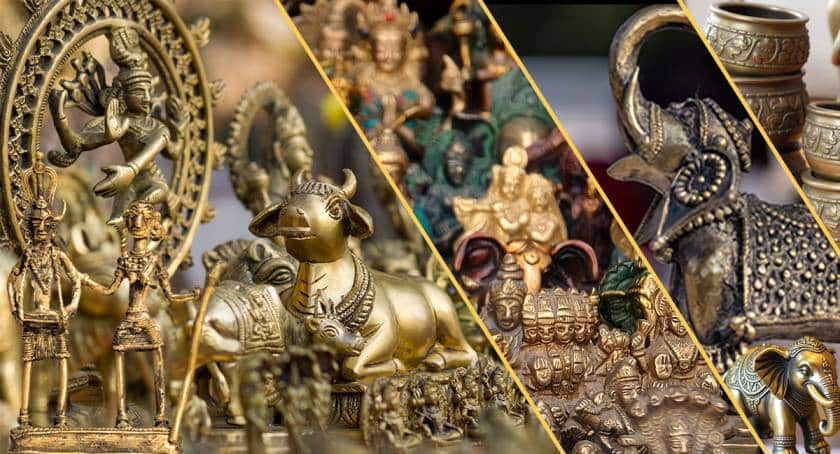Authentic Dhokra Casting Tradition
Odisha, a land steeped in rich traditions and cultural heritage, is home to various indigenous crafts passed down through generations. Dhokra casting is one of the most beautiful and ancient metalworking techniques. This traditional craft, rooted in the tribal communities of Odisha, showcases an extraordinary blend of artistry, mythology, and functionality. Dhokra art, with its rustic charm and complex designs, continues to captivate art lovers, collectors, and historians worldwide.
The Origins of Dhokra Casting
Dhokra casting is an age-old metal casting technique that dates back over 4,000 years. The “Dancing Girl” figurine was discovered in Mohenjo-Daro. Evidence of this lost wax method dates back to the Indus Valley Civilization and has since been preserved. Examples include the famous technique used by several tribal communities in Odisha, especially the Sadeibareni and Jhigidi communities in Dhenkanal and other areas.
The Dhokra Damar tribe, who were the primary practitioners of this craft, is believed to have originated the term Dhokra. Over time, the skill spread across different regions, but Odisha remains a prominent hub for this unique form of metal casting.
The Lost-Wax Dhokra Casting Process
Dhokra casting employs the complex lost-wax method called ‘cire perdue.’ This labor-intensive process involves multiple steps that demand skill and patience:
- Designing the Clay Core: Artisans begin by shaping a clay model of the intended artifact. This core provides the basic form and structure of the final piece. The choice of clay and the precision in shaping ensure that the artifact takes its intended shape.
- Applying a Wax Layer: Artisans apply a layer of beeswax or a mixture of resin and wax over the clay core. The wax is then carefully carved to create elaborate designs and patterns. The artisans use fine tools to ensure the designs are intricate and detailed.
- Adding a Clay Mould: Artisans apply another layer of fine clay over the wax model. This clay covering hardens upon drying, encasing the wax and preparing the mold for casting.
- Heating the Mould: The clay-covered model is heated in a furnace, causing the wax inside to melt and flow through small vents, leaving behind a hollow cavity. This step requires careful temperature control to maintain the mold’s integrity.
- Pouring the Molten Metal: Artisans pour molten brass or bronze into the cavity left by the wax. It fills the complex details of the design before cooling and solidifying. The choice of metal affects the final appearance and durability of the artifact.
- Breaking the Mould: Artisans carefully break the outer clay layer to reveal the final brass or bronze artifact once the metal has cooled. They must break it delicately to avoid damaging the piece.
- Polishing and Finishing Touches: The raw metal piece is then cleaned, polished, and, in some cases, given an antique finish to enhance its visual appeal. This final step determines the aesthetic quality of the finished artifact.
Symbolic Motifs and Inspirations in Dhokra Creations
Dhokra artisans draw inspiration from nature, folklore, and deities and imbue their creations with deep symbolism.
- Tribal Figurines: These represent indigenous lifestyles and their harmonious relationship with nature. Many figurines depict scenes from everyday life, such as women carrying pots or men playing traditional instruments.
- Mythological Motifs: Depictions of Hindu gods like Lord Ganesha, Durga, and Vishnu reflect spiritual and religious influences. People often use these pieces in rituals and as decoration in temples and homes.
- Animal Sculptures: Artisans frequently craft elephants, horses, and peacocks to symbolize strength, grace, and prosperity. People widely use these motifs in festivals and traditional celebrations.
- Ornaments and Utility Items: Dhokra jewelry, lamps, and decorative boxes showcase the versatility of this art. People seek these objects for their rustic elegance and unique charm.
Revitalizing Tradition in a Changing World
With the rise of mechanized production, traditional crafts like Dhokra risk fading into oblivion. However, recent initiatives by the government, NGOs, and independent designers have sparked a renewed interest in this heritage craft. Organizations and individuals have made various efforts to support artisans and expand the reach of Dhokra art.
- Promotion Through Exhibitions: National and international craft fairs showcase Dhokra art, connecting artisans to global buyers. These events help spread awareness and increase demand for traditional handicrafts.
- E-Commerce and Digital Platforms: Online marketplaces have enabled artisans to reach wider audiences, ensuring better financial stability. Digital platforms provide a direct link between creators and consumers, reducing exploitation by intermediaries.
- Designer Collaborations: Fashion and interior designers integrate Dhokra motifs into modern styles, combining traditional and contemporary aesthetics. This adaptation helps keep the art relevant to modern consumers.
Why Dhokra Art Deserves Global Acclaim
Dhokra casting is more than just an art form; it is evidence of human ingenuity and sustainable artistry. Unlike industrial metalwork, Dhokra casting is eco-friendly, utilizing natural materials and minimizing waste. The process aligns with sustainable practices, making it highly relevant in today’s environmentally conscious world. Each artifact embodies a story, a legacy, and a history that deserves to be cherished.
A Tradition Cast in Metal
Dhokra’s casting of Odisha is an enduring legacy, a golden thread that connects us to our past while inspiring the future. As we admire these beautiful metal figurines, we must also recognize the hands that craft them, ensuring that this ancient art continues to shine for generations. By accepting Dhokra, we celebrate not just an art form but the soul of Odisha’s rich cultural heritage. By assisting Dhokra craftspeople, a timeless tradition is maintained, and their artistry can flourish in a changing world.


